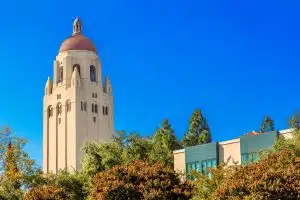Caltech Regular Decisions
The California Institute of Technology (Caltech) is renowned as a world-class research institution, recognized for its highly competitive admissions process and scientifically dedicated student body. This article will focus on shedding light on the recent results from Caltech’s Regular Decision admissions.
Caltech’s Admission Process
Caltech’s application review process is holistic, evaluating a wide range of factors rather than relying on mere statistical data. This approach enables the institution to consider an applicant’s background, individual identity, potential, and promise alongside their academic prowess.
When it comes to the criteria for selection, academic achievement takes the lead as one of the primary factors. Caltech places a specific focus on proficiency in mathematical, scientific, and technical fields. However, the admissions committee also acknowledges the importance of other qualities that go beyond academics. They look for the demonstration of leadership qualities, commitment to community service, involvement in extracurricular activities, and compelling personal essays. The objective is to admit students who are not only academically talented but also demonstrate the desire and potential to contribute positively to the scientific community and society at large.
Caltech’s admission process follows a timeline that prospective applicants should be aware of. The application period typically commences in August every year, giving students ample time to prepare their materials. It is crucial to submit a Regular Decision application by January to be considered for admission. Once all applications are received, the admissions team embarks on a rigorous review process that spans several months. They carefully evaluate each applicant’s academic record, test scores, extracurricular involvement, letters of recommendation, and personal essays. This comprehensive evaluation ensures that every aspect of an applicant’s profile is thoroughly considered.
After months of careful consideration, admissions decisions are usually released in the latter part of March. This eagerly anticipated moment brings both excitement and anticipation for applicants. It is a culmination of their hard work, dedication, and passion for science and technology. Successful applicants receive an invitation to join the prestigious Caltech community, where they will have the opportunity to learn from world-renowned faculty and collaborate with like-minded peers.
Being admitted to Caltech is not just about gaining access to a top-tier education; it is also about becoming part of a tight-knit community of scholars and innovators. The institution values diversity and seeks to create an inclusive environment where students from all backgrounds can thrive. Caltech’s admission process is designed to identify individuals who not only possess exceptional academic abilities but also demonstrate the potential to make a lasting impact on the world through their scientific endeavors.
Breakdown of the Regular Decision Admissions Results
Dissecting the statistics, insights, and trends of the Regular Decision admissions results can paint a clearer picture of the highly selective nature of Caltech’s admissions. Let’s delve deeper into the details and explore some fascinating aspects of the admissions process.
Admission Rates
The admittance rate at Caltech is notoriously low, reflecting the university’s commitment to enrolling a capable and highly motivated student body. During the most recent admissions cycle, the Caltech Regular Decision acceptance rate was approximately 4%, down slightly from the previous year and demonstrating the increasing selectivity of the institution.
Behind this low acceptance rate lies a rigorous evaluation process. Caltech’s admissions committee carefully reviews each application, considering not only academic achievements but also personal qualities, extracurricular involvement, and potential for future contributions to the scientific community. This holistic approach ensures that the admitted students are not only academically exceptional but also possess a passion for scientific discovery.
Furthermore, Caltech’s commitment to diversity is evident in their admissions process. The university actively seeks to enroll students from various backgrounds, fostering a vibrant and inclusive community. The admissions team values diversity in all its forms, including ethnicity, socioeconomic status, and geographic origin.
Diversity in Admissions
Caltech is dedicated to maintaining a diverse scientific community. This commitment is reflected in its admissions. In terms of ethnic diversity, the recent admissions results show an increase in the representation of historically underrepresented groups. Caltech recognizes the importance of providing equal opportunities to students from all backgrounds, ensuring that their campus is a place where diverse perspectives thrive.
On the other hand, gender statistics reveal a nearly equal distribution of males and females admitted, emphasizing Caltech’s dedication to promoting gender equality in STEM fields. The university actively encourages and supports women in pursuing careers in science and engineering, recognizing the immense value they bring to the field.
Caltech’s commitment to diversity extends beyond the admissions process. The university provides various resources and support systems to ensure that all students, regardless of their background, feel included and empowered. From mentorship programs to affinity groups, Caltech fosters an environment where every student can thrive and contribute to the scientific community.
Overall, the Regular Decision admissions results at Caltech exemplify the university’s commitment to excellence, diversity, and inclusivity. The low acceptance rate reflects the institution’s dedication to enrolling the best and brightest minds, while the increasing representation from underrepresented groups and equal gender distribution highlight their efforts to create a diverse scientific community. Caltech’s admissions process is not just about selecting students; it is about shaping a community that values and celebrates the unique contributions of each individual.
Analysis of Admitted Students’ Profiles
To gain a deeper understanding of the characteristics of admitted students, we can observe the academic achievements and geographical distribution of the new enrollees.
When it comes to the academic achievements of admitted students, it is truly remarkable to see the level of excellence displayed by these individuals. Among the accepted students, a large majority displayed extraordinary academic prowess in rigorous STEM-related curriculums. Their dedication and passion for subjects like mathematics, physics, and computer science are truly commendable.
Many of these exceptional students have achieved top-percentile scores in standardized exams, showcasing their exceptional aptitude and knowledge in their respective fields. In addition, they have also enrolled in numerous Advanced Placement (AP) courses, demonstrating their willingness to challenge themselves academically and go above and beyond the regular curriculum.
However, academic achievements are not limited to just test scores and coursework. These admitted students bring countless accolades in science and math competitions, further exemplifying their commitment to their studies and their interests that are perfectly aligned with Caltech’s mission. Their participation and success in these competitions highlight their ability to apply their knowledge and skills in real-world scenarios, setting them apart from their peers.
Turning our attention to the geographical distribution of admitted students, it is evident that Caltech attracts talent from all corners of the globe. The admits come from diverse geographic backgrounds, spanning across all fifty U.S. states and over sixty countries worldwide. This geographic diversity not only adds to the vibrant and multicultural atmosphere on campus but also fosters a global perspective in the scientific discussions and collaborations at Caltech.
By having students from various regions and cultures, Caltech ensures that its community is enriched with different perspectives and experiences. This diversity enhances the learning environment and encourages students to broaden their horizons, think critically, and approach problems from multiple angles.
Impact of COVID-19 on Caltech’s Admissions
The COVID-19 pandemic has dramatically influenced various aspects of academic life, including college admissions. As one of the most prestigious institutions in the world, Caltech has not been immune to these changes.
Caltech, known for its rigorous academic programs and highly selective admissions process, has experienced a significant impact on its application and admission trends due to the pandemic.
Changes in Application and Admission Trends
The pandemic has led to a spike in applications to Caltech, possibly due to the adoption of test-optional policies. With the cancellation of standardized tests like the SAT and ACT, many students have taken advantage of this opportunity to showcase their abilities in other ways. As a result, Caltech has seen a surge in the number of applications it receives each year.
However, despite the increase in applications, admissions rates have decreased. This shift reflects not only changes brought about by the pandemic but also the ongoing trend of heightened competitiveness in college admissions. With more students applying, the acceptance rate has naturally decreased, making it even more challenging for aspiring students to secure a spot at Caltech.
Furthermore, the pandemic has disrupted the traditional college visit and recruitment process. With travel restrictions and social distancing measures in place, prospective students have been unable to visit the campus, attend information sessions, or meet with admissions officers in person. This has forced Caltech, like many other institutions, to adapt to virtual strategies for learning, recruitment, and decision-making.
Future Predictions Based on Current Data
Given the current set of circumstances, it is likely that the competitive nature of Caltech admissions will persist and possibly even intensify in the coming years. The surge in applications and the decrease in admissions rates indicate a growing interest in the institution, as well as the continued emphasis on academic excellence.
The shift to virtual strategies for learning, recruitment, and decision-making might also emerge as a significant influencer in the admissions process. As technology continues to advance and virtual platforms become more sophisticated, Caltech may explore innovative ways to evaluate applicants, such as virtual interviews, online portfolio submissions, and interactive virtual campus tours.
While the long-term effects of the pandemic on college admissions remain uncertain, it is clear that Caltech, like other institutions, will continue to adapt and evolve to meet the challenges posed by these unprecedented times. The dedication to academic excellence and the pursuit of scientific knowledge will remain at the core of Caltech’s admissions process, ensuring that the institution continues to attract the brightest minds from around the world.
Comparing Caltech’s Admissions with Other Institutions
When compared with other high-ranking institutions, Caltech’s unique focus on STEM fields and its smaller size becomes evident.
Caltech, also known as the California Institute of Technology, stands out among other prestigious institutions due to its unwavering commitment to excellence in science, technology, engineering, and mathematics (STEM) fields. With a rich history dating back to 1891, Caltech has consistently produced groundbreaking research and nurtured some of the brightest minds in the world.
One of the distinguishing factors that sets Caltech apart from its peers is its smaller size. Unlike larger universities, Caltech’s intimate campus community fosters close relationships between students and faculty. This tight-knit environment allows for more personalized attention, mentorship, and collaboration, which are crucial elements in nurturing the next generation of scientific leaders.
Admission Rates Comparison
Caltech generally has lower admission rates than some other well-known institutions, due in part to its specific focus and smaller class sizes. Though exact comparative rates vary from year to year, Caltech’s precise concentration on producing leaders in science and engineering contributes to its distinctive admission rates.
Caltech’s rigorous admission process ensures that only the most exceptional and passionate students are admitted. The institution seeks individuals who not only possess outstanding academic achievements but also demonstrate a genuine passion for scientific exploration and a desire to make a significant impact on the world. As a result, the competition for admission to Caltech is fierce, with thousands of highly qualified applicants vying for a limited number of spots.
However, despite the intense competition, Caltech remains committed to providing opportunities for students from diverse backgrounds. The admissions committee recognizes the importance of creating a vibrant and inclusive community that reflects the diversity of the world we live in.
Diversity Comparison
In terms of diversity, Caltech’s concerted efforts to increase representation from various ethnicities and genders are comparable to many top-tier institutions. However, it is notable that the institution’s regional diversity is particularly pronounced, a result of its global outreach and reputation in the STEM fields.
Caltech actively seeks to attract students from all walks of life, recognizing that diversity fosters innovation and enriches the educational experience. The institution actively supports programs and initiatives aimed at increasing the representation of underrepresented groups in STEM, including women, people of color, and individuals from low-income backgrounds.
Moreover, Caltech’s global reputation as a leading institution in STEM fields attracts talented students from around the world. The diverse perspectives and experiences brought by international students contribute to the vibrant and multicultural atmosphere on campus.
Caltech’s commitment to diversity extends beyond the student body. The institution also strives to create an inclusive and supportive environment for faculty and staff, recognizing that a diverse community of scholars enhances the quality of research and education.
Final Thoughts
Caltech’s Regular Decision admissions results reveal a multifaceted image of the institution—committed to diversity, driven by academic excellence and resilience amid unforeseen circumstances. As the larger trends pertaining to application numbers and diversity continue to evolve, so too will the intricacies of Caltech’s Regular Decision admissions process.
AdmissionSight is a college consulting firm that provides personalized assistance to students throughout the college admissions process. We can provide valuable guidance and support throughout the college admissions process to help you maximize your chances of getting accepted into the college of your choice.
With a high success rate of over 75%, we have built a strong network in the past decade. Book an initial consultation today, free of charge!








































